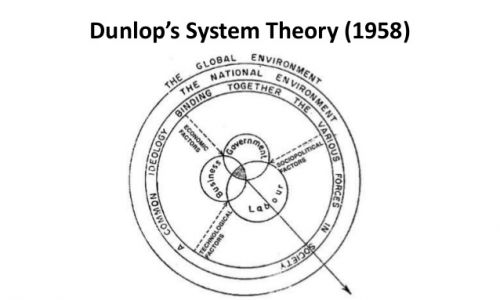One of the significant theories of industrial labor relations was put forth by John Dunlop in the 1950s. According to Dunlop’s System Model of Industrial Relations consists of three agents – management organizations, workers and formal/informal ways they are organized and government agencies. These actors and their organizations are located within an environment – defined in terms of technology, labor and product markets, and the distribution of power in wider society as it impacts upon individuals and workplace. Within this environment, actors interact with each other, negotiate and use economic/political power in process of determining rules that constitute the output of the industrial relations system. He proposed that three parties-employers, labor unions, and government– are the
key actors in a modern industrial relations system. He also argued that none of these institutions could act in an autonomous or independent fashion. Instead they were shaped, at least to some extent, by their market, technological and political contexts.
Thus it can be said that industrial relations industrial relations is a social sub system subject to three environmental constraints- the markets, distribution of power in society and technology.
Dunlop’s model identifies three key factors to be considered in conducting an analysis of the management-labor relationship:
- Environmental or external economic, technological, political, legal and social forces that impact employment relationships.
- Characteristics and interaction of the key actors in the employment relationship: labor, management, and government.
- Rules that are derived from these interactions that govern the employment relationship.
Dunlop emphasizes the core idea of systems by saying that the arrangements in the field of industrial relations may be regarded as a system in the sense that each of them more or less intimately affects each of the others so that they constitute a group of arrangements for dealing with certain matters and are collectively responsible for certain results”..
In effect – Industrial relations is the system which produces the rules of the workplace. Such rules are the product of interaction between three key “actors” – workers/unions, employers and associated organizations and government
The Dunlop’s model gives great significance to external or environmental forces. In other words, management, labor, and the government possess a shared ideology that defines their roles within the relationship and provides stability to the system.
Coutesy: Naukrihub.com



